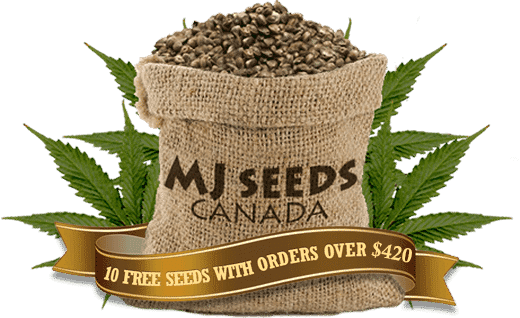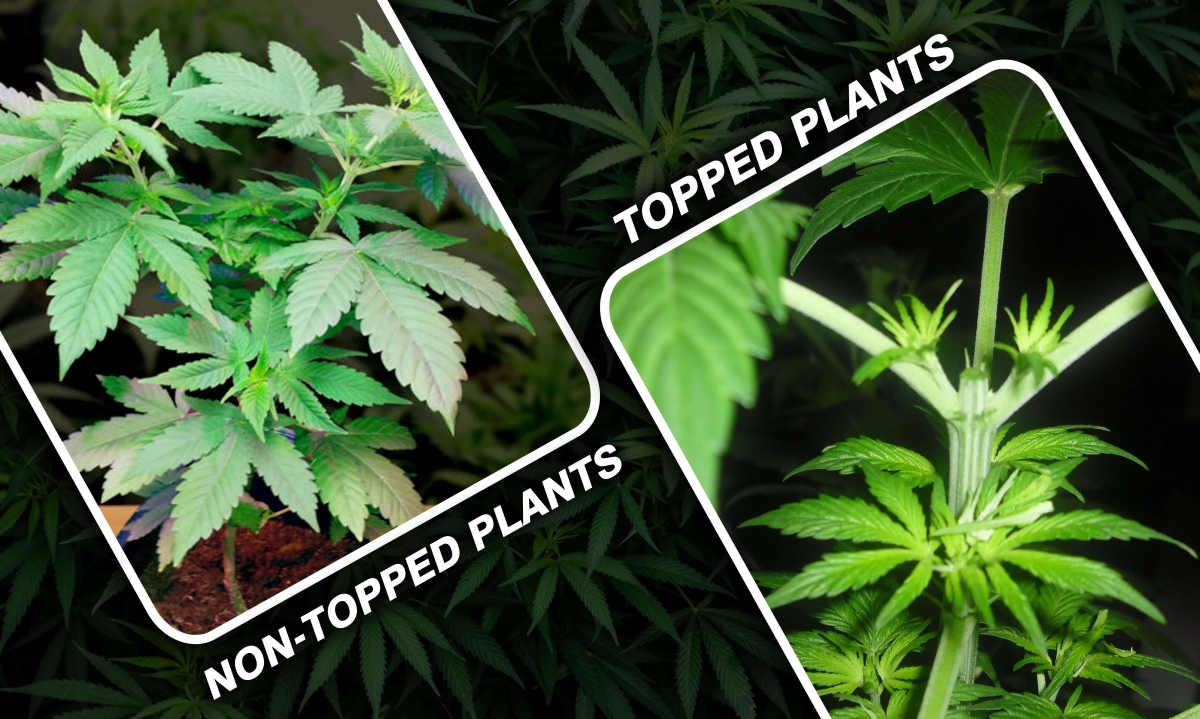The final production of cannabis plants is greatly influenced by the decision to top or leave intact. Redirecting growth hormones to the lateral branches and cutting off the tip of the main shoot is known as topping. As a result, the plants become bushier and have more colas, which may increase yields. Topped plant vs non topped plants: On the other hand, untopped plants retain a noticeable central cola, which may restrict lateral development and total production.
Cannabis cultivation involves various techniques aimed at enhancing plant growth and maximizing yield. To promote lateral growth, one such method is topping, which entails cutting off the apical meristem. Nonetheless, growers continue to disagree on whether or not to top cannabis plants. To find out whether topping is effective in optimizing yields, we explore the advantages and disadvantages of topped and non-topped cannabis plants in this article.
Table of Contents
Topping Weed Plants
What is Topping?
Non-Topped Weed Plants
Pros and Cons of Topping Cannabis Plants
Advantages of Topped Plants
Considerations for Topped Plants
Advantages of Non-Topped Plants
Considerations for Non-Topped Plants
Is Topping Worth It?
When Should You Top Off A Plant?
Is It Okay To Not Top Weed Plants?
Conclusion
FAQs
Topping Weed Plants
What is Topping?
Topping is the process of cutting off the tip of the main stem to encourage the growth of several colas. This method promotes lateral branching, which makes the plant structure bushier. Trimming the tips of cannabis plants redirects energy towards lateral branches, reducing apical dominance. This process boosts the number of bud sites and has the potential to increase overall yields.
Topping plants can greatly increase the harvest’s overall yield. Cannabis plants that have been topped have a denser canopy, which allows more light to reach the buds evenly and improves photosynthesis. This method is helpful for small-space indoor growing since it helps control plant height.
Non-Topped Weed Plants
Non-topped cannabis plants are allowed to grow naturally without any intentional pruning of the main stem. While they may have fewer colds compared to topped plants, they follow a more traditional growth pattern dictated by apical dominance.
Non-topped plants require less intervention and maintenance, making them suitable for novice growers or those seeking a hands-off approach to cultivation. It allows the plant to maintain its apical dominance can result in a more natural growth structure, potentially enhancing the plant’s resilience and vigor. Lastly, Non-topped plants may initiate flowering earlier than topped plants since they devote less energy to lateral growth during the vegetative stage.
Pros and Cons of Topping Cannabis Plants
Advantages of Topped Plants
Bushier Growth
By stimulating lateral branching, topping encourages the development of a denser canopy, ideal for ornamental plants or those grown for foliage.
Control of Height
A weed plant can be topped to reduce excessive vertical growth, which is useful for controlling the size of indoor plants or plants grown in small spaces.
Increased Flowering Sites
The proliferation of lateral shoots provides more sites for flower formation, potentially leading to a more abundant floral display.
Considerations for Topped Plants
Pruning Frequency: Topped plants may require more frequent pruning to maintain their desired shape and size.
Vulnerability to Damage: The removal of the terminal bud can make topped plants more susceptible to environmental stressors such as wind damage or pest attacks.
Delayed Flowering: While topped plants may produce more flowering sites, the onset of flowering may be delayed compared to non-topped counterparts.
Advantages of Non-Topped Plants
Natural Growth Habit: Non-topped plants follow their innate growth patterns, which can be advantageous for certain species or cultivars.
Enhanced Structural Strength: The presence of a dominant central leader can confer greater structural stability, reducing the risk of breakage or lodging.
Potentially Faster Flowering: Non-topped plants may initiate flowering earlier than their topped counterparts, as they are not subject to the growth interruption caused by pruning.
Considerations for Non-Topped Plants
Height Management: Without topping, non-topped plants may become excessively tall, necessitating measures such as staking or selective pruning to maintain manageable height.
Sparse Foliage: In some cases, non-topped plants may exhibit a more open canopy with less foliage density, which may be undesirable for certain aesthetic or functional purposes.
Limited Branching: The absence of topping marijuana plants may result in fewer lateral branches, potentially reducing the overall volume of foliage or flowers produced.
Overall, the decision between topped and non-topped plants depends on many variables, such as the traits of the species, the goals of growth, and environmental limitations. Topped plants have advantages including better branching and height control, but untopped plants keep a more organic growth pattern and may flower sooner. In the end, growers should carefully analyze these factors to decide which pruning strategy best suits their unique requirements and preferences.
Is Topping Worth It?
Cannabis plant topping ultimately comes down to many things, including the grower’s background, the cultivation environment, and the yield that is wanted. Although topping encourages a more robust canopy and can increase production potential, it must be done with much thought and care.
Topping can be beneficial for experienced growers who are skilled at controlling plant stress and development patterns, particularly when trying to achieve optimum yields in a small area. On the other hand, non-topped plants reduce the possibility of issues and guarantee an easier growing experience for inexperienced gardeners or those looking for a more straightforward cultivation method.
When Should You Top Off A Plant?
Topping off a plant is a crucial technique in gardening that involves removing the apical meristem, or the top growth, to promote lateral growth and bushier plants. Knowing when to top off a plant is essential for optimal results. Typically, it’s best to top off a plant during the vegetative stage when it has developed a few sets of true leaves and is actively growing. This timing allows the plant to recover quickly and redirect its energy towards lateral growth.
However, it’s important to avoid topping off plants during times of stress, such as extreme heat or drought, as this can hinder recovery and overall plant health. Observing the plant’s growth patterns and ensuring it’s in a healthy and vigorous state are key indicators for when to top off. By timing this process correctly, gardeners can encourage stronger, bushier plants with increased yields.
Is It Okay To Not Top Weed Plants?
Non-topped plants undergo less stress since they are allowed to grow without interference. This reduced stress can contribute to healthier plants and potentially better overall crop performance. By allowing the plant to follow its natural growth pattern without pruning or topping, cultivators can simplify their cultivation process, making it ideal for beginners or those seeking a low-maintenance approach.
Overall, cannabis plants without tops provide ease of maintenance, an organic growth pattern, decreased strain, and possible benefits in terms of flowering stages beginning and height control. By allowing the plant to grow without interference, cultivators can harness the inherent resilience and genetic potential of the cannabis strain while minimizing the complexities associated with topping and pruning.
Conclusion
Topping cannabis plants is a cultivation technique that can significantly impact yield and overall plant structure. While topping promotes lateral growth and canopy uniformity, it also requires careful timing and execution to avoid potential drawbacks such as stunted growth or stress-induced yield loss. Ultimately, the decision to top or not to top cannabis plants depends on the grower’s preferences, experience level, and cultivation goals. By weighing the pros and cons of each approach, growers can determine the most suitable method for maximizing yield potential and achieving successful harvests.
FAQs
1. Is topping plants worth it?
Pruning the apical meristem, known as topping, promotes lateral branch development and the formation of multiple colas, leading to a higher plant yield through the cultivation of shorter plants with increased bud production. This method is widely embraced by growers employing the sea of green (SOG) approach.
2. What plants need to be topped?
Trimming your plant is advisable once it has grown at least four internodes. An internode refers to the segment of stem situated between two nodes, with a node being the point along the stem where lateral branches emerge. Hence, if your plant displays five side branches, it’s an opportune time to commence trimming.
3. What does it mean when a plant is topped?
Topping, as a pruning technique, entails trimming the primary stem or branches of a plant to stimulate lateral growth while curbing its upward expansion. While employing this method may yield denser and more compact vegetation, it’s important to note that it doesn’t diminish the plant’s total height.
4. What happens when you cut off the top of a plant?
Trimming the upper portion of a plant commonly triggers the proliferation of stem growth by inducing the plant to generate additional auxins, which are natural plant hormones fostering the elongation of stems. This phenomenon is referred to as apical dominance and serves as an inherent protective mechanism for the plant to restore its typical growth pattern.
5. Is topping indica or sativa better?
Indica varieties often display a denser, more condensed growth structure, rendering topping beneficial for regulating their stature and optimizing crop output. Conversely, Sativa strains tend to exhibit greater elongation, and topping serves to manage their upward growth, fostering a well-balanced foliage cover.




